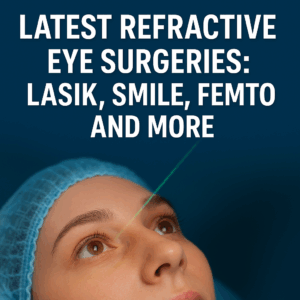
Anushka Super Speciality Eye Hospital
Call: 90044 44422 / 99213 44422 | Timings : 8.30 a.m to 5.30 p.m (Mon-Sat) | Add: Shri Swami Samarth Soc, Kaneri Dhamankar Naka, Bhiwandi




Accredited for Quality Care
Conjunctivitis (Pink Eye): Types, Symptoms, Treatment & Prevention
anushka
5 June 2025
Introduction
Conjunctivitis, commonly called “pink eye,” is one of the most frequent eye problems seen in clinics. It causes redness, watering, irritation, and discharge from the eyes. While it’s usually not serious, conjunctivitis can be uncomfortable, highly contagious, and occasionally lead to complications if untreated. This blog explains the types, causes, symptoms, and both conservative and medical treatments for conjunctivitis, with a focus on proper care—especially for viral conjunctivitis.
What Is Conjunctivitis?
Conjunctivitis is inflammation of the conjunctiva, the thin transparent layer covering the white part of the eye and the inside of the eyelids. It causes the eye to appear pink or red, which is why it’s popularly known as “pink eye.”
Types of Conjunctivitis
Conjunctivitis is broadly classified into four types:
1. Viral Conjunctivitis
- Cause: Most often caused by adenoviruses; can also be due to herpes simplex or varicella-zoster virus.
- Transmission: Highly contagious via direct contact, respiratory droplets, or contaminated surfaces.
- Symptoms:
- Watery discharge
- Redness in one or both eyes
- Gritty feeling or burning
- Swollen eyelids
- Often associated with cold, sore throat, or fever
- Special Cases: Herpetic conjunctivitis may cause blisters or corneal involvement.
2. Bacterial Conjunctivitis
- Cause: Caused by bacteria like Staphylococcus aureus, Streptococcus pneumoniae, or Haemophilus influenzae.
- Transmission: Spreads through direct contact or contaminated hands and surfaces.
- Symptoms:
- Thick yellow or green discharge
- Eyelids stuck together, especially in the morning
- Mild discomfort or pain
- Redness
3. Allergic Conjunctivitis
- Cause: Allergic reactions to pollen, pet dander, dust, cosmetics, or other allergens.
- Transmission: Not contagious.
- Symptoms:
- Intense itching
- Tearing
- Puffy, swollen eyelids
- Often seasonal and affects both eyes
4. Chemical or Irritant Conjunctivitis
- Cause: Exposure to irritants like chlorine (swimming pools), smoke, fumes, or chemical splashes.
- Symptoms:
- Immediate redness and tearing.
- Burning or stinging sensation.
- Eye pain or discomfort.
Treatment of Conjunctivitis
Proper treatment depends on the type of conjunctivitis. Even though viral conjunctivitis is self-limiting, symptomatic and supportive care is essential to reduce discomfort, prevent complications, and avoid transmission.
Conservative/Home-Based Treatment
Helpful for all types, especially mild viral and allergic cases:
1. Hygiene Practices
- Wash hands regularly.
- Avoid touching or rubbing your eyes.
- Use clean tissues to wipe discharge.
- Don’t share towels, cosmetics, or pillowcases.
2. Cold or Warm Compress
- Cold compress: For itching, swelling (allergic or viral).
- Warm compress: For bacterial cases to loosen dried secretions.
3. Artificial Tears / Lubricant Eye Drops
- Soothe irritation and wash away particles or allergens.
- Recommended 4–6 times a day.
4. Avoid Contact Lenses
- Stop lens wear until complete recovery to avoid corneal complications.
Medical Treatment Plan
1. Viral Conjunctivitis
Even though antibiotics don’t work against viruses, treatment is necessary for comfort and healing:
- Supportive care:
- Lubricant drops
- Cold compresses
- Antihistamine drops (if itching is severe)
- Topical steroids (only under ophthalmologist supervision) if there’s corneal inflammation (epithelial keratitis or subepithelial infiltrates).
- Antiviral medication (like acyclovir) in herpetic cases.
- Povidone-iodine eye drops (0.6–1%): Increasingly used to reduce viral load and hasten recovery (under prescription).
Note: Most viral conjunctivitis cases resolve in 7–14 days, but symptoms can worsen before improving. Never self-medicate with steroid drops.
2. Bacterial Conjunctivitis
- Antibiotic eye drops or ointments:
- Moxifloxacin 0.5%
- Tobramycin 0.3%
- Ciprofloxacin (especially in contact lens users)
- Dosage: 4–6 times daily for 5–7 days.
- Most cases improve within 3 days.
3. Allergic Conjunctivitis
- Antihistamine drops: Olopatadine, Ketotifen
- Mast cell stabilizers: Cromolyn sodium
- Oral antihistamines: For severe allergic symptoms
- Steroid drops: For refractory cases under specialist care
- Avoid allergens and use sunglasses to block pollen
4. Chemical Conjunctivitis
- Immediate eye irrigation with saline or clean water
- Use lubricating drops and preservative-free artificial tears
- Severe cases may require topical corticosteroids
When to See a Doctor
See an ophthalmologist if you experience:
- Vision disturbances or blurring
- Eye pain or light sensitivity
- Thick or worsening discharge
- Symptoms lasting more than 7–10 days
- A history of recurrent eye infections
- Herpes history or vesicles around the eyes
Prevention Tips
- Maintain proper hand hygiene.
- Avoid close contact with infected individuals.
- Disinfect surfaces and electronic devices.
- Do not reuse contaminated eye makeup or contact lenses.
- Keep children with conjunctivitis at home to prevent outbreaks in schools.
Frequently Asked Questions About Conjunctivitis
Q1. Is conjunctivitis contagious?
Yes, viral and bacterial types are contagious. Allergic and chemical types are not.
Q2. How do I know if it’s viral or bacterial?
- Viral: Watery discharge, often with cold or sore throat
- Bacterial: Thick, sticky yellow/green discharge and eyelids stuck together
Q3. How long does conjunctivitis last?
- Viral: 7–14 days
- Bacterial: 3–5 days with treatment
- Allergic: As long as the allergen is present
- Chemical: Resolves once irritant is removed
Q4. Can viral conjunctivitis damage my eyes?
Usually not, but severe cases can involve the cornea (keratitis), leading to blurred vision. Prompt treatment helps prevent complications.
Q5. Should I use antibiotics just in case?
No. Antibiotics are ineffective against viruses and may cause resistance. Use them only if prescribed for bacterial infections.
Q6. Can I go to work or school with conjunctivitis?
It’s best to stay home if your conjunctivitis is viral or bacterial, as they are contagious. You can return once symptoms improve or after 48 hours of starting antibiotics.
Q7. Can I treat conjunctivitis at home?
Mild viral or allergic cases can be managed at home with lubricants and hygiene. However, it’s best to consult an eye doctor for proper diagnosis and treatment.
Conclusion
Conjunctivitis is a manageable condition, but knowing its type is key to proper treatment. While viral conjunctivitis often resolves on its own, symptomatic treatment is essential to ease discomfort and reduce transmission. Bacterial cases require antibiotics, and allergic cases benefit from antihistamines and allergen avoidance. Maintaining hygiene and seeking timely care can help prevent complications and ensure a quicker recovery.
Recent Posts


